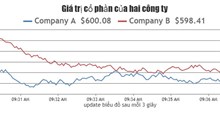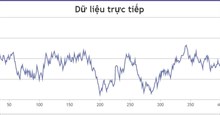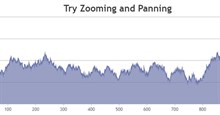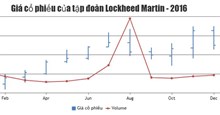Code mẫu biểu đồ được đồng bộ hóa trong JavaScript
Code mẫu biểu đồ bằng JavaScript dưới đây khá đặc biệt. Tất cả đều được đồng bộ với nhau. Dưới đây là ví dụ code mẫu JavaScript tại biểu đồ kèm ví dụ trực quan.
Dù có thể hiển thị dữ liệu trên nhiều biểu đồ, bạn có thể “hình ảnh hóa” chúng tốt hơn bằng cách dùng Synchronized Charts - Đồng bộ hóa biểu đồ/đồ thị. Dạng biểu đồ này là nơi tooltip, đường chéo & phạm vi trục được đồng bộ trên các biểu đồ. Ví dụ, nếu bạn phóng to, thu nhỏ hoặc xoay bất kỳ một trong số các biểu đồ, nó sẽ tự động zoom/pan các biểu đồ khác. Điều đó cũng diễn ra trên Tooltip & Crosshair.
Dưới đây là ví dụ về code mẫu JavaScript tạo biểu đồ được đồng bộ hóa cùng với mã nguồn mà bạn có thể chạy trên máy tính:

<!DOCTYPE HTML>
<html>
<head>
<script>
window.onload = function () {
var charts = [];
var toolTip = {
shared: true
},
legend = {
cursor: "pointer",
itemclick: function (e) {
if (typeof (e.dataSeries.visible) === "undefined" || e.dataSeries.visible) {
e.dataSeries.visible = false;
} else {
e.dataSeries.visible = true;
}
e.chart.render();
}
};
var systemDps = [], userDps=[], waitDps = [], buffersDps = [], cacheDps = [], usedDps=[], inboundDps = [], outboundDps = [], writeDps = [], readDps = [];
var cpuChartOptions = {
animationEnabled: true,
theme: "light2", // bạn có thể thay bằng "light1", "light2", "dark1" hoặc "dark2"
title:{
text: "Sử dụng CPU"
},
toolTip: toolTip,
axisY: {
valueFormatString: "#0.#%",
},
legend: legend,
data: [{
type: "splineArea",
showInLegend: "true",
name: "User",
yValueFormatString: "#0.#%",
color: "#64b5f6",
xValueType: "dateTime",
xValueFormatString: "DD MMM YY HH:mm",
legendMarkerType: "square",
dataPoints: userDps
},{
type: "splineArea",
showInLegend: "true",
name: "System",
yValueFormatString: "#0.#%",
color: "#2196f3",
xValueType: "dateTime",
xValueFormatString: "DD MMM YY HH:mm",
legendMarkerType: "square",
dataPoints: systemDps
},{
type: "splineArea",
showInLegend: "true",
name: "Wait",
yValueFormatString: "#0.#%",
color: "#1976d2",
xValueType: "dateTime",
xValueFormatString: "DD MMM YY HH:mm",
legendMarkerType: "square",
dataPoints: waitDps
}]
};
var memoryChartOptions = {
animationEnabled: true,
theme: "light2",
title:{
text: "Sử dụng bộ nhớ"
},
axisY: {
suffix: " GB"
},
toolTip: toolTip,
legend: legend,
data: [{
type: "splineArea",
showInLegend: "true",
name: "Cache",
color: "#e57373",
xValueType: "dateTime",
xValueFormatString: "DD MMM YY HH:mm",
yValueFormatString: "#.## GB",
legendMarkerType: "square",
dataPoints: cacheDps
},{
type: "splineArea",
showInLegend: "true",
name: "Buffers",
color: "#f44336",
xValueType: "dateTime",
xValueFormatString: "DD MMM YY HH:mm",
yValueFormatString: "#.## GB",
legendMarkerType: "square",
dataPoints: buffersDps
},{
type: "splineArea",
showInLegend: "true",
name: "Used",
color: "#d32f2f",
xValueType: "dateTime",
xValueFormatString: "DD MMM YY HH:mm",
yValueFormatString: "#.## GB",
legendMarkerType: "square",
dataPoints: usedDps
}]
}
var networkChartOptions = {
animationEnabled: true,
theme: "light2",
title:{
text: "Lưu lượng truy cập"
},
axisY: {
suffix: " Kb/s"
},
toolTip: toolTip,
legend: legend,
data: [{
type: "splineArea",
showInLegend: "true",
name: "Outbound",
color: "#81c784",
xValueType: "dateTime",
xValueFormatString: "DD MMM YY HH:mm",
yValueFormatString: "#.## Kb/s",
legendMarkerType: "square",
dataPoints: outboundDps
},{
type: "splineArea",
showInLegend: "true",
name: "Inbound",
color: "#388e3c",
xValueType: "dateTime",
xValueFormatString: "DD MMM YY HH:mm",
yValueFormatString: "#.## Kb/s",
legendMarkerType: "square",
dataPoints: inboundDps
}]
}
var diskChartOptions = {
animationEnabled: true,
theme: "light2",
title:{
text: "Disk I/O (IOPS)"
},
axisY: {},
toolTip: toolTip,
legend: legend,
data: [{
type: "splineArea",
showInLegend: "true",
name: "Write",
color: "#ffb74d",
xValueType: "dateTime",
xValueFormatString: "DD MMM YY HH:mm",
yValueFormatString: "#.## ops/second",
legendMarkerType: "square",
dataPoints: writeDps
},{
type: "splineArea",
showInLegend: "true",
name: "Read",
color: "#f57c00",
xValueType: "dateTime",
xValueFormatString: "DD MMM YY HH:mm",
yValueFormatString: "#.## ops/second",
legendMarkerType: "square",
dataPoints: readDps
}]
}
charts.push(new CanvasJS.Chart("chartContainer1", cpuChartOptions));
charts.push(new CanvasJS.Chart("chartContainer2", memoryChartOptions));
charts.push(new CanvasJS.Chart("chartContainer3", networkChartOptions));
charts.push(new CanvasJS.Chart("chartContainer4", diskChartOptions));
$.get("https://canvasjs.com/data/gallery/javascript/server-matrics.json", function(data) {
for (var i = 1; i < data.length; i++) {
systemDps.push({x: parseInt(data[i].time), y: parseFloat(data[i].system)});
userDps.push({x: parseInt(data[i].time), y: parseFloat(data[i].user)});
waitDps.push({x: parseInt(data[i].time), y: parseFloat(data[i].wait)});
buffersDps.push({x: parseInt(data[i].time), y: parseFloat(data[i].buffers)});
cacheDps.push({x: parseInt(data[i].time), y: parseFloat(data[i].cache)});
usedDps.push({x: parseInt(data[i].time), y: parseFloat(data[i].used)});
inboundDps.push({x: parseInt(data[i].time), y: parseFloat(data[i].inbound)});
outboundDps.push({x: parseInt(data[i].time), y: parseFloat(data[i].outbound)});
writeDps.push({x: parseInt(data[i].time), y: parseFloat(data[i].write)});
readDps.push({x: parseInt(data[i].time), y: parseFloat(data[i].read)});
}
for( var i = 0; i < charts.length; i++){
charts[i].options.axisX = {
labelAngle: 0,
crosshair: {
enabled: true,
snapToDataPoint: true,
valueFormatString: "HH:mm"
}
}
}
syncCharts(charts, true, true, true); // syncCharts(charts, syncToolTip, syncCrosshair, syncAxisXRange)
for( var i = 0; i < charts.length; i++){
charts[i].render();
}
});
function syncCharts(charts, syncToolTip, syncCrosshair, syncAxisXRange) {
if(!this.onToolTipUpdated){
this.onToolTipUpdated = function(e) {
for (var j = 0; j < charts.length; j++) {
if (charts[j] != e.chart)
charts[j].toolTip.showAtX(e.entries[0].xValue);
}
}
}
if(!this.onToolTipHidden){
this.onToolTipHidden = function(e) {
for( var j = 0; j < charts.length; j++){
if(charts[j] != e.chart)
charts[j].toolTip.hide();
}
}
}
if(!this.onCrosshairUpdated){
this.onCrosshairUpdated = function(e) {
for(var j = 0; j < charts.length; j++){
if(charts[j] != e.chart)
charts[j].axisX[0].crosshair.showAt(e.value);
}
}
}
if(!this.onCrosshairHidden){
this.onCrosshairHidden = function(e) {
for( var j = 0; j < charts.length; j++){
if(charts[j] != e.chart)
charts[j].axisX[0].crosshair.hide();
}
}
}
if(!this.onRangeChanged){
this.onRangeChanged = function(e) {
for (var j = 0; j < charts.length; j++) {
if (e.trigger === "reset") {
charts[j].options.axisX.viewportMinimum = charts[j].options.axisX.viewportMaximum = null;
charts[j].options.axisY.viewportMinimum = charts[j].options.axisY.viewportMaximum = null;
charts[j].render();
} else if (charts[j] !== e.chart) {
charts[j].options.axisX.viewportMinimum = e.axisX[0].viewportMinimum;
charts[j].options.axisX.viewportMaximum = e.axisX[0].viewportMaximum;
charts[j].render();
}
}
}
}
for(var i = 0; i < charts.length; i++) {
//Sync ToolTip
if(syncToolTip) {
if(!charts[i].options.toolTip)
charts[i].options.toolTip = {};
charts[i].options.toolTip.updated = this.onToolTipUpdated;
charts[i].options.toolTip.hidden = this.onToolTipHidden;
}
//Sync Crosshair
if(syncCrosshair) {
if(!charts[i].options.axisX)
charts[i].options.axisX = { crosshair: { enabled: true }};
charts[i].options.axisX.crosshair.updated = this.onCrosshairUpdated;
charts[i].options.axisX.crosshair.hidden = this.onCrosshairHidden;
}
//Sync Zoom / Pan
if(syncAxisXRange) {
charts[i].options.zoomEnabled = true;
charts[i].options.rangeChanged = this.onRangeChanged;
}
}
}
}
</script>
<style>
.row:after {
content: "";
display: table;
clear: both;
}
.col {
float: left;
width: 50%;
height: 270px;
}
</style>
</head>
<body>
<div class="row">
<div class="col"id="chartContainer1"></div>
<div class="col" id="chartContainer2"></div>
</div>
<div class="row">
<div class="col" id="chartContainer3"></div>
<div class="col" id="chartContainer4"></div>
</div>
<script type="text/javascript" src="https://canvasjs.com/assets/script/jquery-1.11.1.min.js"></script>
<script src="https://canvasjs.com/assets/script/canvasjs.min.js"></script>
</body>
</html>Nguồn: CanvaJS
Tùy biến biểu đồ
Ví dụ trên đang dùng các sự kiện và phương pháp sau:
- Chart - rangeChanging, rangeChanged
- ToolTip - updated, hidden, showAtX, hide
- Crosshair - updated, hidden, showAt, hide
Bạn nên đọc
-

Sự khác biệt giữa JavaScript và Python
-

Code mẫu biểu đồ & đồ thị JavaScript với label Index/ Data
-

Code JavaScript tạo biểu đồ đa chuỗi update dữ liệu trực tiếp
-

Code JavaScript tạo biểu đồ/đồ thị đường dạng động
-

Code mẫu biểu đồ nhiều chuỗi dữ liệu trong JavaScript
-

Tổng hợp bài tập JavaScript có code mẫu
-

Code mẫu JavaScript tạo biểu đồ/đồ thị với Zoom và Pan
-

Code JavaScript tạo mẫu biểu đồ kết hợp OHLC và biểu đồ đường
-

JavaScript là gì?
Theo Nghị định 147/2024/ND-CP, bạn cần xác thực tài khoản trước khi sử dụng tính năng này. Chúng tôi sẽ gửi mã xác thực qua SMS hoặc Zalo tới số điện thoại mà bạn nhập dưới đây:
Cũ vẫn chất
-

Sửa lỗi 0x80070643 trên Windows
Hôm qua -

Những trang web đen siêu hay không thể tìm thấy trên Google
Hôm qua 3 -

Cách chia sẻ một thư mục (folder) trên Windows 10
Hôm qua -

Cách cho người lạ xem Nhật ký Zalo
Hôm qua -

Stt về tiền hài hước, những câu nói hài hước về tiền nhưng thâm thúy, ‘thô mà thật’
Hôm qua -

30+ bài thơ về rượu bia hay, thơ chế về rượu bia hài hước và bá đạo cho dân nhậu
Hôm qua -

Tổng hợp thao tác Touchpad trên Windows 10, Windows 11
Hôm qua -

Công thức tính chu vi hình tứ giác, diện tích hình tứ giác
Hôm qua 1 -

Cài đặt Python Package với PIP trên Windows, Mac và Linux
Hôm qua -

Những stt hay nói về miệng lưỡi thế gian đáng để suy ngẫm
Hôm qua
 Công nghệ
Công nghệ  AI
AI  Windows
Windows  iPhone
iPhone  Android
Android  Học IT
Học IT  Download
Download  Tiện ích
Tiện ích  Khoa học
Khoa học  Game
Game  Làng CN
Làng CN  Ứng dụng
Ứng dụng 








 Linux
Linux  Đồng hồ thông minh
Đồng hồ thông minh  macOS
macOS  Chụp ảnh - Quay phim
Chụp ảnh - Quay phim  Thủ thuật SEO
Thủ thuật SEO  Phần cứng
Phần cứng  Kiến thức cơ bản
Kiến thức cơ bản  Lập trình
Lập trình  Dịch vụ công trực tuyến
Dịch vụ công trực tuyến  Dịch vụ nhà mạng
Dịch vụ nhà mạng  Quiz công nghệ
Quiz công nghệ  Microsoft Word 2016
Microsoft Word 2016  Microsoft Word 2013
Microsoft Word 2013  Microsoft Word 2007
Microsoft Word 2007  Microsoft Excel 2019
Microsoft Excel 2019  Microsoft Excel 2016
Microsoft Excel 2016  Microsoft PowerPoint 2019
Microsoft PowerPoint 2019  Google Sheets
Google Sheets  Học Photoshop
Học Photoshop  Lập trình Scratch
Lập trình Scratch  Bootstrap
Bootstrap  Năng suất
Năng suất  Game - Trò chơi
Game - Trò chơi  Hệ thống
Hệ thống  Thiết kế & Đồ họa
Thiết kế & Đồ họa  Internet
Internet  Bảo mật, Antivirus
Bảo mật, Antivirus  Doanh nghiệp
Doanh nghiệp  Ảnh & Video
Ảnh & Video  Giải trí & Âm nhạc
Giải trí & Âm nhạc  Mạng xã hội
Mạng xã hội  Lập trình
Lập trình  Giáo dục - Học tập
Giáo dục - Học tập  Lối sống
Lối sống  Tài chính & Mua sắm
Tài chính & Mua sắm  AI Trí tuệ nhân tạo
AI Trí tuệ nhân tạo  ChatGPT
ChatGPT  Gemini
Gemini  Điện máy
Điện máy  Tivi
Tivi  Tủ lạnh
Tủ lạnh  Điều hòa
Điều hòa  Máy giặt
Máy giặt  Cuộc sống
Cuộc sống  TOP
TOP  Kỹ năng
Kỹ năng  Món ngon mỗi ngày
Món ngon mỗi ngày  Nuôi dạy con
Nuôi dạy con  Mẹo vặt
Mẹo vặt  Phim ảnh, Truyện
Phim ảnh, Truyện  Làm đẹp
Làm đẹp  DIY - Handmade
DIY - Handmade  Du lịch
Du lịch  Quà tặng
Quà tặng  Giải trí
Giải trí  Là gì?
Là gì?  Nhà đẹp
Nhà đẹp  Giáng sinh - Noel
Giáng sinh - Noel  Hướng dẫn
Hướng dẫn  Ô tô, Xe máy
Ô tô, Xe máy  Tấn công mạng
Tấn công mạng  Chuyện công nghệ
Chuyện công nghệ  Công nghệ mới
Công nghệ mới  Trí tuệ Thiên tài
Trí tuệ Thiên tài